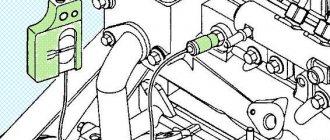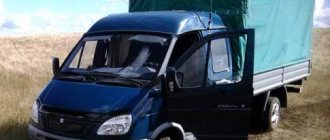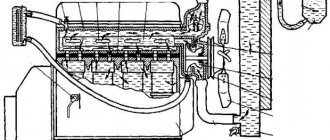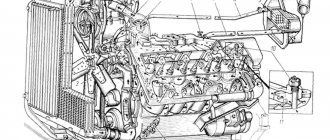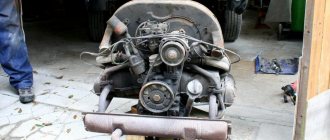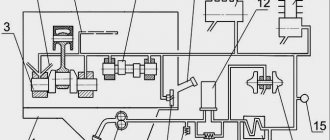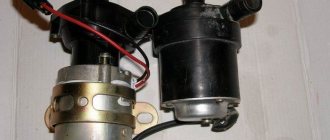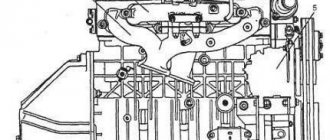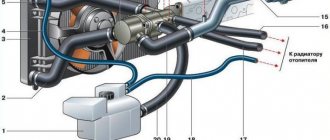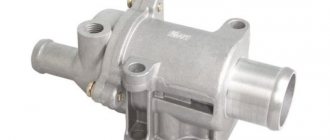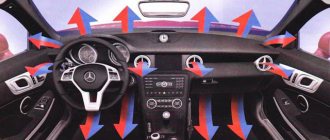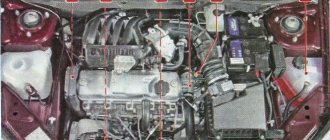Gazelle ZMZ 405 is heating up
There are a lot of topics with that name, I’ve read many of them, but I have one difference. While I'm driving, the temperature on the dashboard stays somewhere around 85 degrees. When I stop, the temperature starts to rise rapidly and reaches 100, according to the tidy, again, the fan turns on, cools quickly enough to 85-90, rises again, cools again, etc. When I start driving it rises to 85. It doesn’t overheat and doesn’t go into the red zone. I changed the thermostat today, it didn't help, the coolant is fresh. By the way, it all started after I changed the coolant and the pipes were about 5-6 (cracked), the same coolant is used by people I know that are normal.
The gasket is broken. While you drive, the pump pumps. Doesn't push on xx
Try unscrewing the cap on the expansion valve. If it helps, then a gasket. Although the 405m has a metal package. Breakdowns are rare there
Isn't the stove getting colder at this moment?
Message from
HypnocatIsn't the stove getting colder at this moment?
the stove is always hot
Message from
HypnocatThe gasket is broken. While you drive, the pump pumps. Doesn't push on xx
12 thousand km ago the block and gasket were changed accordingly.
Try the lid trick. Well, put a hot condom on the extension and look. If the gasket or crack inflates quickly.
Is there an additional pump for the stove?
Message from
HypnocatIs there an additional pump for the stove?
No
Message from
HypnocatTry the lid trick. Well, put a hot condom on the extension and look. If the gasket or crack inflates quickly.
The point is that if I saw this problem during this time, it started exactly after my intervention with replacing the pipes, flushing and replacing the coolant
Or maybe it's the temperature sensor that's going crazy?
They're lying. You have a clear pattern. As an option. Drain the coolant into a canister and fill it with water. You ride. If the glitch disappears, it needs to be replaced. I had this happen once. It boiled ahead of time.
Everything is fine, when you stand still, the radiator is not blowing, so the temperature rises. On the move it is blown and there is no heating. Me too.
Last edited by mozes; 06.11.2017 at 22:12.
CR-V 97 LPG Sunny 02 LPG
But not up to a hundred. There seems to be a sensor in the radiator at 82 degrees. Although it is possible that the computer is already turning on the fan. And if it grows very quickly, which was not the case before, then there is either an air lock or a pump. IMHO
Posted by
mozesEverything is fine, when you stand still, the radiator is not blowing, so the temperature rises.
On the move it is blown and there is no heating. Me too.
What nonsense... It should be in place in one pore...temperature.
Some people think that they rose... In fact, they just surfaced.
Message from
HypnocatBut not up to a hundred. There seems to be a sensor in the radiator at 82 degrees. Although it is possible that the computer is already turning on the fan. And if it grows very quickly, which was not the case before, then there is either an air lock or a pump. IMHO
On the gazelle, the operating temperature seems to be about one hundred.
The younger the blogger, the worse his life was under Stalin (c)
It actually looks like a clogged radiator.
The younger the blogger, the worse his life was under Stalin (c)
Message from
Ours have won!On the gazelle, the operating temperature seems to be about one hundred.
88 opens for me...
Some people think that they rose... In fact, they just surfaced.
Posted by
mozesEverything is fine, when you stand still, the radiator is not blowing, so the temperature rises. On the move it is blown and there is no heating. Me too.
On the street -5, on the car the arrow is in place at xx
Service Manual
There are several generally accepted recommendations that help extend the trouble-free operation of power units. Compliance with them allows you to increase the engine life indicated by the manufacturer:
- The quality of the liquids poured into the engine comes first. If possible, it is advisable to use fuel and oil brands offered by the manufacturer. The same requirements apply to the coolant;
- The manufacturer clearly defines the timing of regular maintenance. Its frequency depends on the mileage traveled by the car or the operating time of the engine;
- even at first glance, a serviceable power unit needs major repairs after 250 thousand kilometers. It is for this distance that the performance of most functional units is designed, after which their wear reaches critical values.
Failure to comply with the above measures can have a detrimental effect on engine performance, ranging from an unreasonable drop in power to an increase in fuel and lubricant consumption.
The author of this article is not even close to the practical aspects of the ZMZ engine, but we all know how to “get smart”: 1. “The internal cylinder capacity of 2.46 liters allows the unit to compare in agility with 140 horses. This allows even a loaded car to easily perform various maneuvers” - an empty car in the wind and downhill, otherwise - 3-4 gear. Sit and ride; 2. “The improvements did not affect the size of the cylinder block and did not affect the connecting rods” - why? Connecting rod bushings have been broken and continue to break unexpectedly for the owners. In the best case - replacing the connecting rods with bushings, in the worst case - replacing the block, if it’s a little late; 3.” The four-stroke engine has a number of extremely easy-to-maintain versions. All of them are cooled by a forced circulating liquid in a closed-type system” - and this absolutely ill-thought-out solution of coolant circulation is constantly a consequence of cylinder head overheating; 4.”On the highway, the ZMZ engine consumes only 8.8 liters of fuel. When moving on city roads, the unit consumes 13.5 liters. For the mixed cycle, the indicator is 11 liters per 100 km.” – quickly jump into any “caselle” on the move and do your super-smart math, “smart guy”; 5. “Specially cut holes between the cylinders contribute to an accelerated decrease in the temperature of the internal combustion engine” - they contribute to accelerated burnout of the cylinder head gasket, and not the internal combustion engine seal; 6. “He is not afraid of sudden changes in temperature. It functions equally well both at −40 and at +45” - drive at +45 loaded to the maximum and in a traffic jam without overheating, and we’ll see how many meters you drive until you install the Toyota radiator and thermostat, viscous coupling and a BMW fan and a smaller pump pulley to increase the latter’s speed at idle; 7. “if the fine fuel filters become excessively dirty, the filter element needs to be renewed” – does the word “excessive” mean that bits of dirt fall out of the filter or am I missing something? This word is NOT APPLICABLE when cleaning fuel and lubricants of internal combustion engines. 8. “the appearance of bluish smoke, accompanied by increased oil consumption, indicates wear of the piston rings” - and who canceled the fallen, swollen or worn oil seals on the valves? You can even run into a bluish smoke a month after the CD; 9. “by adjusting the injection advance angle you can get rid of black smoke, accompanied by an increase in fuel consumption” - is this the type of distributor with carburetor that ZMZ produces? Nothing surprising. Not far from this yet...; 10. “Even at first glance, a serviceable power unit needs major repairs after 250 thousand kilometers. It is for this distance that the performance of most functional units is designed, after which their wear reaches critical values” - oh well. 25,000 km WITHOUT OVERHEATING AND OVERLOAD IN THE CITY WITHOUT TRAFFIC TRAFFIC – burnout of the cylinder head gasket: the upper plane of the block is a rocker arm, the pistons are hanging out and must only be replaced and protrude above the surface of the block, the bushings on 2 connecting rods are completely worn out (and this is briefly about ZMZ products); 11. “worn crankshaft bearings cause a decrease in oil pressure” - believe me, afftor, it won’t come to that. At first, the hydraulic compensators will rattle heart-rendingly, the timing chain will crack, the pin bushings in the connecting rods will knock, the sensor needle will be at 0, the emergency sensor light will not go out at medium speeds, then: “worn crankshaft bearings cause a decrease in oil pressure” BUT THIS HAS TO BE THE AUTHOR THIS TEXT, do not know the technique AT ALL and DO NOT KNOW WHAT A GAZELLE LOOKS EVEN FROM A FAR. Far from technology - don’t get into the comments. It's even disgusting to read. Guys, if possible, install all foreign internal combustion engines and you will not know grief. Russian internal combustion engines, and ZMZ in particular, do not even deserve our mocking glance. This is a disgrace to the country, like all technology. And not only technology.
Kamens engine operating temperature
During operation of the Cummins engine, the temperature of the gases inside its working cylinders constantly changes from 80 to 2200 degrees.
In this case, the minimum value corresponds to the air temperature at the end of the intake, and the maximum corresponds to the combustion process of the working mixture. Considering the rather high combustion temperature of finely atomized liquid fuel, it is not difficult to guess that the engine design itself, when operating under such conditions, can warm up to a significant temperature.
However, already when the mark reaches 100 degrees, overheating of the engine parts occurs and dilution of its lubricant is observed. A decrease in lubricant density, in turn, increases friction and accelerates wear of contacting surfaces, which adversely affects their service life.
The operating temperature of the Kamens engine in GAZelle, KamAZ and other vehicles is 90…95 degrees.
It should be noted that failure to comply with the lower limit is also dangerous for the technical condition of the engine. Overcooling, as a rule, leads to a deterioration in the mixture formation process and an increase in energy losses due to friction, as a result of which the wear rate increases
piston rings
,
pistons
and workers
cylinders
.
Common malfunctions, their possible causes and recommendations for elimination
Although the units in question are characterized by increased reliability, breakdowns may occur in them. Some of them require the intervention of specialized service professionals. However, there are malfunctions that even a novice car enthusiast can fix with his own hands:
- If the power unit has problems starting, you should check the fuel intake. A possible reason lies in its clogging. The problem is solved by washing the part followed by blowing;
- if air leaks into the pipeline connecting the fuel pump to the gas tank, it is necessary to ensure its complete tightness;
- by replacing a faulty part, the problem with the electronic control system and power plant is eliminated;
- if fine fuel filters become excessively dirty, the filter element needs to be renewed;
- if air enters the fuel system, measures must be taken to ensure its tightness;
- By timely replacing the pump injector, you can restore the functionality of the pump responsible for supplying fuel;
- the appearance of bluish smoke, accompanied by increased oil consumption, indicates wear of the piston rings. The problem is solved by installing new serviceable parts;
- by adjusting the injection advance angle, you can get rid of black smoke, accompanied by an increase in fuel consumption;
- Worn crankshaft bearings cause low oil pressure. Immediate repairs with updating of unusable parts can restore the indicators required by technical standards.
ZMZ-406 cooling system diagram
It is closed, liquid and consists of standard components and elements that are included in the cooling system of any other engine. The system includes a thermostat, radiator, pipes, cooling jacket, pump and other elements.
There are also other details. This is a drain valve on the cylinder block, a heater radiator, a heater valve and an electric motor, a throttle heating unit, temperature sensors, a fan, and thermostat valves.
Composition of the Gazelle cooling system
Any engine cooling system consists of certain components, each of which performs its own function. So, to understand what the entire structure of the system consists of and the purpose of the nodes, it is not enough to look at the diagram. Let's look at all the details, as well as their characteristics.
Radiator
The radiator is one of the indispensable parts of the cooling system. It is in this element that the coolant is cooled and circulates through the system. The Gazelle is often equipped with an aluminum radiator, in which tubes run in three rows.
It has an inlet and an outlet, where the hot “coolant” enters the first, and the cooled liquid comes out of the second. Cooling occurs due to the oncoming wind flow that passes through the part.
Electric fan
If the radiator cannot cope, a cooling fan comes to the aid of the radiator, which operates automatically when the temperature of the liquid in the system reaches 105 degrees. At the same time, the fan quickly and efficiently cools the radiator cells, and when the temperature drops, it turns off.
This unit is turned on and off using a coolant temperature sensor and an electronic engine control unit, which regulates all engine operation processes.
Thermostat
The thermostat is one of the elements that is familiar to almost all motorists. The element helps warm up the engine and also cool it. As you know, car engines have two cooling circles, each of which performs its own function. So, if the thermostat is closed, then the liquid circulates in a small circle without the participation of the radiator.
Typically, this system is necessary for quick and efficient warming up of the power unit. When the thermostat opens (at 65-70 degrees), the coolant begins to circulate through the radiator, which allows it not to overheat.
The temperature sensor is the only electrical part of the engine cooling system that reads system temperature data and sends it to the electronic engine control unit. Subsequently, the “brains”, based on the data received, make a decision whether to turn on the cooling fan or not.
It is worth noting that the malfunction of this sensor usually brings many problems to the owners of the power unit, since based on temperature data, not only the activation of the electric fan is regulated, but also fuel consumption, as well as the operation of auxiliary systems.
Expansion tank
The expansion tank is a plastic container that is located above the other elements of the cooling system and shows the level of “cooling” in the engine. In addition, excess fluid from the system is squeezed into it.
A very important cooling element is the expansion tank plug, since it is through it that hot or boiling coolant will be squeezed out if the power unit overheats. It also serves as a valve that indicates problems in the cooling system.
Water pump
One of the most important elements of the engine is the water pump or simply pump. This unit ensures coolant circulation throughout the entire system. The faster the pump runs, the faster the engine cools.
Design Features
Initially, the ZMZ 405 engine included the following promising technical solutions for 2000:
- distributed injection inside the cylinder head channels;
- in-line engine diagram with two timing shafts for 4 valves in each cylinder;
- closed ventilation circuit with vacuum inside the crankcase;
- updated attachments in the form of a two-valve thermostat, a thermoresistive coolant sensor, an induction synchronizer, a Hall sensor and a magnetoresistive throttle module;
Cylinder block design
Cylinder head ZMZ 405
Forged connecting rods, steel-aluminum crankshaft bearing shells, rubber-coated damper pulley to dampen harmful vibrations.
Technical features
The predecessor of the ZMZ-405 motor is the 406 model, which is the base for the unit in question. The improvements did not affect the size of the cylinder block and did not affect the connecting rods.
The four-stroke engine has a number of extremely easy-to-maintain versions. All of them are cooled by forcedly circulating liquid in a closed-type system.
First of all, I would like to note the very impressive technical characteristics of the ZMZ-405 power plant, which meets Euro-2 standards. The internal cylinder capacity of 2.46 liters allows the unit to match the agility of 140 horses. This allows even a loaded vehicle to easily perform various maneuvers.
The engine is characterized by a maximum torque of 214 Nm. This is ensured thanks to the cast iron crankshaft ZMZ-406 with a full-bearing device. Its design includes eight special counterweights that optimally unload the mechanism from the adverse effects of centrifugal force with torques.
As for fuel consumption parameters, there is an excellent opportunity for savings. On the highway, the ZMZ engine consumes only 8.8 liters of fuel. When moving on city roads, the unit consumes 13.5 liters. For the mixed cycle, the indicator is 11 liters per 100 km.
Particularly attractive to domestic car owners is the climatic endurance demonstrated by the ZMZ engine. He is not afraid of sudden temperature changes. It functions equally well both at −40 and at +45 0 C.
It should be noted that the description of the cooling system of the ZMZ 405 model engine, which complies with Euro-2 standards, deserves special mention. It is characterized by the presence of a large cross-section piston.
Specially cut holes between the cylinders contribute to an accelerated decrease in the temperature of the internal combustion engine. The developers also managed to improve the work with antifreeze.
List of internal combustion engine modifications
The manufacturer ZMZ has 4 naturally aspirated modifications of the 405 series engine for buses, trucks and heavy executive Volgas, and one turbocharged version for special vehicles with armored linings, special equipment, and heavy frames.
The basic version 4052.10 has 214 Nm of torque, a compression ratio of 9.4, and a power of 152 hp. It is recommended for use both in the urban cycle and on the highway.
Motor 40522.10 has a lower torque of 211 Nm, the power remains the same, it is adapted for the gearboxes of Gazelle/Sobol trucks and buses. The compression ratio here is 9.3 for better responsiveness to domestic gasoline.
ZMZ 40522.10
Option 40524.10, on the contrary, is tailored to fit the box of the Fiat Ducato minibus, although it was actively used on Gazelles and Sobols. Meets the requirements of Euro-3 and Euro-4 in different configurations, has 214 Nm of torque and 140.5 hp. With. power. The compression ratio is 9.4, that is, the same as the base version.
ZMZ 40524.10
ICE 40525.10 has 213.5 Nm of torque and 143.8 hp. With. power, developed under Euro-3 regulations for GAZ Volga weighing up to 2.1 tons.
ZMZ 40525.10
Unlike previous naturally aspirated engines, modification 4024.10 is equipped with an air cooler and turbocharger, forged pistons and a steel crankshaft for increased loads. The diaphragm spring is strengthened here, and the exhaust valves are equipped with sodium cooling. In 2009, this turbo engine was equipped with Fiat Ducato buses. The compression ratio here is reduced to 7.4 units, the torque is increased to 343 Nm, and the power it develops is 195 hp. With.
ZMZ 4054.10 turbo
Engine ZMZ-405
The ZMZ-405 family of gasoline engines can rightfully be considered one of their pride. The high quality of these motors has been confirmed by years of operation, and often in rather harsh conditions.
4-cylinder, in-line injection engines ZMZ-405 appeared on the market in 2000. The ZMZ-405 engine uses an optimized valve cover, a ventilation system with the supply of crankcase gases to the receiver and a timing gear drive by toothed chains. The supply of fuel to the cylinder inlet ports and ignition is controlled by an electronic system. The engine is equipped with a system for external formation of the fuel-air mixture.
Specifications
90
| Production | ZMZ |
| Engine make | ZMZ-405 |
| Years of manufacture | 2000-present day |
| Cylinder block material | cast iron |
| Supply system | injector |
| Type | in-line |
| Number of cylinders | 4 |
| Valves per cylinder | 4 |
| Piston stroke, mm | 86 |
| Cylinder diameter, mm | 95.5 |
| Compression ratio | 9.3 |
| Engine capacity, cc | 2464 |
| Engine power, hp/rpm | 152/5200 |
| Torque, Nm/rpm | 211/4200 |
| Fuel | 92 |
| Environmental standards | Euro 3 |
| Engine weight, kg | 193 |
| Fuel consumption, l/100 km - city - highway - mixed. | 13.5 8.8 11.0 |
| Oil consumption, g/1000 km | up to 100 |
| Engine oil | 5W-30 / 5W-40 / 10W-30 / 10W-40 / 15W-40 / 20W-40 |
| How much oil is in the engine | 6 |
| When replacing, pour, l | 5.4 |
| Oil change carried out, km | 7000 |
| Engine operating temperature, degrees. | |
| Engine life, thousand km - according to the plant - in practice | 150 250+ |
Common faults and operation
- poor quality of cooling system components often leads to overheating;
- The timing chain breaks regularly (the valves do not bend);
- there are lubricant leaks from the gap between the oil deflector and the valve cover;
- many problems with ignition coils, sensors and high-voltage wires
- The oil scraper rings quickly become stuck and oil burns appear.
Modifications of the internal combustion engine ZMZ-405
- 4052.1000401, 40520B. Complete set with KMSUD and ECU Mikas 7.1, without accessory drive belt - for GAZ-3111 with power steering.
- 4052.1000401-10, 40520С. Complete with KMSUD and ECU Mikas 7.1, without accessory drive belt - for GAZ-3111 with power steering and air conditioning.
- 4052.1000400-10, 40520A. Complete set in a single design with KMSUD and Mikas 7.1 ECU.
- 40522.1000400, 405220. Basic complete set in a single design with KMSUD and Mikas 7.1 ECU.
- 40522.1000400-10, 40522A. Complete with KMSUD and Mikas 7.1 ECU, without accessory drive belt.
- 40522.1000400-80, 40522M. Complete with KMSUD and ECU Mikas 7.1 - for cars with a two-way radiator.
- 40522.1000400-90, 40522N. Complete with KMSUD and ECU Mikas 7.1, without accessory drive belt - for cars with a two-way radiator.
- 40522.1000400-100, 40522P. Complete with KMSUD and Mikas 11 ECU, fuel line for quick-release connection, ignition coils for sealed AMP connector.
- 40522.1000400-110, 40522R. Complete with KMSUD and Mikas 11 ECU, fuel line for quick-release coupling, ignition coils for sealed AMP connector, without accessory drive belt.
- 40522.1000400-120, 40522S. Complete with KMSUD and Mikas 11 ECU, ignition coils with a low voltage socket block for a sealed AMP connector.
- 40522.1000400-130, 40522T. Complete with KMSUD and ECU Mikas 11, ignition coils with a low voltage socket block for a sealed AMP connector, without an accessory drive belt.
- 40522.1000400-111, 40522U. Complete set in version T2 with KMSUD and ECU Mikas 11, fuel line for quick-release coupling, ignition coils with low voltage socket block for sealed AMP connector, without accessory drive belt.
- 40524.1000400, 405240. Basic complete set with drive belt 6PK1275.
- 40524.1000400-01, 405240. Complete with accessory drive belt 6PK1413 - for vehicles with a power steering pump.
- 40524.1000400-11, 405240. Complete with a 90A generator, with an accessory drive belt 6PK1413 - for special ambulance vehicles with power steering.
- 40524.1000400-02, 405240. Complete set in T2 version with accessory drive belt 6PK1413 - for vehicles with power steering pump.
- 40525.1000400, 405250. Complete with accessory drive belt 6PK1275.
- 40525.1000400-01, 405250. Complete with accessory drive belt 6PK1413, with power steering pump.
- 40525.1000400-10, 405250. Complete with double-groove crankshaft pulley, 6PK1275 accessory drive belt, power steering and air conditioning compressor.
- 4054.1000400, 40540О. Engine with a displacement of 2.5 liters, with electrical equipment, with KMSUD, with a turbocharger, with a forged piston, for UAZ vehicles with power steering.
Environmental standards
The first modifications of the 405 engine complied with Euro 2 environmental standards.
In order to meet international environmental standards, the plant's designers modernized the engine in 2009, bringing it to the Euro-3 standard. Thus, modifications ZMZ-40522 (24) appeared in the line. In 2013, a ban was issued on the production of installations whose environmental class is lower than third. For these reasons, the 405th engine produced today mandatory uses an injector and is suitable for Euro 3 class and higher.
Advantages and disadvantages
The advantages of power drives of the 405 family of the manufacturer ZMZ are:
- the cylinder head is modified through the use of a two-layer metal gasket 0.5 mm thick with spring elements;
- the cylinder block reduced the weight by 1.35 kg, since the attachment was partially dismantled - there are no more TPS, pipes and an idle regulator;
- three-component catalytic converter to comply with Euro-3 regulations;
- mechanical tuning by plant engineers made it possible to reduce fuel consumption to 8.8 l/100 km on the highway;
- a lubricant purification system was used.
ShPG motor ZMZ 405
The ignition timing is controlled by a microprocessor of the electronic system, which, on the one hand, is a plus, on the other hand, a minus, since repairs on the highway become more complicated. Due to hydraulic compensation of the thermal clearance of the valves, the operating budget has been reduced; now the user does not need to regularly visit a service station to adjust the valves.
Timing drive
The disadvantage is the significant weight of the motor, the danger of the chain jumping over several links and a decrease in the strength of the cylinder block due to slotted slots.
water pump
The pump causes the coolant to move, or circulate, through the system. The pump is located in the cylinder block and is driven by a belt. Torque is taken from the engine crankshaft. The pump life for these engines is about 100 thousand kilometers. But due to low-quality spare parts, the resource may be significantly less.
The pump is most often non-separable, modern, so if the pump fails, the assembly should be replaced.
Pipes and cooling jacket
The pipes serve as a conductive and connecting link between different parts of the cooling system. Due to worn pipes, antifreeze may leave the system and the engine may overheat.
Antifreeze circulates through the cooling jacket in the block, absorbing heat. Then the liquid is discharged through it into the radiator. Due to a breakdown of the cooling jacket, a water hammer may occur. This is a very dangerous phenomenon for any internal combustion engine.
Parts and spare parts: description
Many car enthusiasts are familiar with the elements of the engine cooling system. But, novice motorists do not know what this unit consists of and what the purpose of the elements is, for which they are often punished by fate. So, let’s look at the purpose of individual elements of the cooling system of the ZMZ 406 engine.
Thermostat
The thermostat is an element of the car’s cooling system, which plays the role of a valve that redirects the coolant flow from small to large. The operating temperature of the ZMZ 406 power unit is 87 – 103 degrees Celsius.
When the car warms up, the thermostat is closed, which allows the engine to heat up more quickly and efficiently. After the liquid temperature reaches 60-70 degrees, the thermostat opens and the coolant begins to circulate in a large circle, passing through the radiator.
The thermostat can rightfully be considered the most broken part of a car's cooling system. This is often due to the fact that the unit is jammed and the motor either overheats or does not heat up. The simplest solution to the problem is to replace the damaged part.
A - thermostat is closed; B - thermostat open
Water pump
A water pump or water pump circulates coolant throughout the system. The part is located in the cylinder block and is driven by a drive belt from the crankshaft. The part has a service life of 100,000 km, but due to low-quality spare parts it can fail much earlier.
Radiator and fan
The radiator and coolant fan are designed to ensure optimal engine cooling. The radiator itself is cooled with the help of a counter flow of air, but in the summer this is not enough, and the fan turns on.
The cooling system radiator on the ZMZ 406 is installed in aluminum with a 3-row system to ensure maximum cooling of the liquid. The fan is activated by automatically closing a circuit with a temperature sensor located on the cylinder block.
If the engine has an injector, then the electronic engine control unit is also included in the sensor-fan operating circuit. The coolant temperature sensor causes many problems related to engine performance.
Pipes and water jacket
The pipes play the role of a conductive and connecting link between different elements of the coolant system. Due to their malfunction, a coolant leak may occur, and the engine will simply begin to overheat.
Coolant circulates through the water jacket in the power unit, where it absorbs heat and transfers it to the radiator. Due to the breakdown of this element, a water hammer may occur.
This is due to the operation of the power unit on water, which causes corrosion.
Expansion tank plug
Despite the fact that the plug is small, its role in the cooling system is very important. Pressure is squeezed out through it, as well as boiling antifreeze in case of engine overheating. A special valve is installed inside the plug, due to which excess pressure is released.
There are two valves in the plug and each of them performs its own separate function. So, the exhaust valve of the plug is needed to work with excess pressure when the engine is hot. The intake will open if the pressure is low (that is, the engine is cooling down).
Characteristics of the cooling system
The Gazelle was equipped with engines from the Zavolzhsky Motor Plant marked ZMZ 402, ZMZ 405 and ZMZ 406. The design, circuit and operating principle of all three cooling systems are similar. Of course, there are some differences, but they are not that big.
Like any other cooling system, the ZMZ 405 engine has both positive and negative sides. So, if the thermostat breaks down, the power unit begins to overheat very much, especially in the summer season, when the temperature outside is 30 degrees Celsius or higher.
The most dangerous thing in this case is the failure of the cooling fan.
The cooling scheme of the 405 engine is quite typical for all power units produced by ZMZ. The Gazelle 405 engine cooling system looks like this:
Electrical diagram
The electrical circuit diagram of the car and the ZMZ 406 engine is quite simple, especially when there is a complete decoding of all symbols. Let's look at the electrical system diagram, as well as the explanation of the main technical symbols:
Symbols for electrical circuits of GAZ 31105 with engine 406
- A9 - Submersible pump module (ZMZ-40621)
- 81 — Oil pressure indicator sensor
- 82 - Sensor for emergency oil pressure drop
- 87 - Coolant temperature gauge sensor
- 88 — Coolant overheat warning sensor
- B12 - Fuel level indicator sensor
- B20 - Electric fan activation sensor
- B46 - Speedometer sensor
- B64 - Air temperature sensor in the intake manifold (ZMZ-4062)
- 867 — Sensor for emergency drop in brake fluid level
- 868 — Ignition distributor sensor (ZMZ-402)
- B70 - Engine management system coolant temperature sensor
- 874 — Speed and synchronization sensor (ZMZ-4062)
- 875 — Air flow sensor (ZMZ-4062)
- 876 — Air throttle position sensor (ZMZ-4062)
- B83 - Anti-icer
- 891 — Phase sensor (ZMZ-4062)
- 892 — Knock sensor (ZMZ-4062)
- 893 — Carburetor air damper cover indicator sensor (ZMZ-402)
- B95 - Pressure sensor
- D4 - EPHH control unit (ZMZ-402)
- D7 - ABS unit
- D23 - Engine control unit (ZMZ-4062)
- D29 - Door lock control unit
- E1 - Left headlight
- E2 - Right headlight
- EZ - Left fog lamp
- E4 - Right fog lamp
- E7 - Front left turn signal
- E8 - Front right turn indicator
- E9 - Left turn signal repeater
- EY - Right turn signal repeater
- E16 - Ceiling light
- E27 — Rear left lamp
- E28 — Rear right lamp
- EZO, E72 — License plate lights
- E31 — Rear fog lamp
- E35 — Engine compartment lamp
- E59 - Cigarette lighter
- E61 — Trunk light
- E64 — Taxi lamp
- E66 - Medical sign lantern (GAZ-310231)
- E67 — Headlight finder (GAZ-310231)
- E68, E69 — Interior lamps (GAZ-310231)
- E70 — Tailgate lamp (GAZ-310221)
- E71 - Glove box lighting
- E80 - Additional brake signal
- E81, E82 — Rear lights in the trunk lid
- F1- F4 - Spark plugs
- F30 - 10A air conditioner fuse
- F36 - 25A fuse in the headlight wiper circuit
- F41 - Left fuse block
- F42 - Fuse box right
- F43 - Fuse box in the engine compartment
- G1 - Generator
- G2 - Battery
- 1Н.Н2 — Sound signal
- H7 - Alarm for emergency drop in oil pressure
- H8 - Coolant overheating indicator
- H16 - Right turn signal
- H17 - Left turn signal
- H19 - Indicator of the minimum fuel reserve in the tank
- H20 - Headlight high beam indicator
- H30 - Parking brake indicator
- H54 - Battery discharge indicator
- H56 - Alarm for emergency drop in brake fluid level
- Н62, Н63 — Front side light lamps
- H64, H65 — Headlight lamps
- H66 - H69 - Instrument lighting lamps
- H70, H71 — Rear fog lamps
- H72, H73 — Reversing lamps
- H74, H75 — Brake signal lamps
- H76, H77 — Tail lamps
- H78, H79 — Rear turn signal lamps
- H80 - Side light indicator
- H81 — Alarm-backup
- N91 - Engine control system indicator (ZMZ-4062)
- N92 - Carburetor air damper cover indicator (ZMZ-402)
- H97 - Seat heating indicator
- H98, H99 — Low beam lamps
- H100, H101 — High beam lamp
- Н102, Н103 — Front turn signal lamp
- K1 - Starter relay
- Short circuit - Wiper relay
- K6 - Air conditioner mode relay
- K7 - Horn relay
- K9 - Electric fuel pump relay (ZMZ-4062)
- K12 - Turn signal interrupter
- K13 - Parking brake warning switch
- K18 - High beam relay
- K19 - Low beam relay
- K20 - Fog lamp relay
- K30 - Headlight cleaner relay (GAZ-3102)
- K36 - Electric fan relay
- K40 - Headlight relay
- K42 - Rear window heating relay
- K46 - Engine control system relay
- K52 - Relay for checking instrument cluster warning lights
- K54 - Seat heating relay
- K56 - Air conditioner relay
- K57 - Compressor clutch relay
- K71 - Rear fog lights relay
- K72 - EPHH system relay (ZMZ-402)
- M1 - Starter
- M2 - Heater fan motor
- M3 - Electric cooling fan (ZMZ-4062)
- M4 - Windshield wiper motor
- M5 - Electric windshield washer pump
- M6 - Electric fuel pump (ZMZ-4062)
- M15 - Electric motor for headlight cleaner (GAZ-3102)
- M19 - Antenna motor
- M20 - Rear heater electric motor
- M24 - Right rear view mirror
- M25 - Left rear view mirror
- M26, M29 — Electric window lifter motor
- MZZ - Electric fan of the air conditioning system
- M38, M39 — Electric headlight range control
- M40 - Air conditioner condenser fan
- M50-M53 — Door locking motor
- P1 - Speedometer
- P2 - Instrument cluster
- RZ - Tachometer
- P5 - Voltage indicator
- P6 - Coolant temperature indicator
- P7 - Oil pressure indicator
- P8 - Fuel level indicator
- R1-R4 - Noise suppression resistors (ZMZ-402)
- R12 — Additional resistor for heater fan electric motor
- R13 — Additional resistor for the rear heater fan electric motor (GAZ-310231)
- R14 - Rear window heating element
- R17, R18 — Seat heating elements
- R25, R26 — Electric heating jets for windshield washer
- R28 - Air conditioning resistor
- S1 - Ignition switch
- S5 - Hazard switch
- S6 - Heater fan switch
- S9 - Turn signal switch
- S12 - Wiper switch
- S15 - Switch for heating elements of rear-view mirrors
- S18 - Rear fog light switch
- S19 - Fog light switch
- S29 - Reversing light switch
- S30 - Brake light switch
- S36 - Horn switch
- S39 - Central light switch
- S50 - Mirror control switch
- S52 - Parking brake warning switch
- S54 - Instrument cluster indicator switch
- S61 - Rear window heating switch
- S63 - Antenna switch
- S70, S71 — Door lamp switches
- S72 - EPHH system switch (ZMZ-402)
- S73 — Rear heater fan switch (GAZ-310231)
- S75 - Finder headlight switch (GAZ-310231)
- S76 — Interior lamp switch (GAZ-310231)
- S77 - Glove compartment lamp switch
- S81-S84 — Power window switch
- S91, S92 - Seat heating switches
- S109 — Windshield washer jet heating switch
- S116 — Switch for electric headlight adjustment
- S117 - Air conditioning fan switch
- S118 - Air conditioning switch
- S131 — Carburetor air damper closed indicator switch (ZMZ-402)
- T1, T4 - Ignition coils
- U2 - Radio
- VI - Voltage regulator (ZMZ-402)
- V2 - Transistor switch (ZMZ-402)
- XI - Plug socket (GAZ-310231)
- X51 - Diagnostic connector (ZMZ-4062)
- X52 - Connector
- Y3 - Electromagnetic valve EPHH (ZMZ-402)
- Y19-Y22 — Injectors (ZMZ-4062)
- Y23 — Idle speed regulator (ZMZ-4062)
- Y27 - Air conditioning compressor clutch
